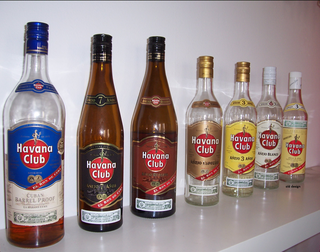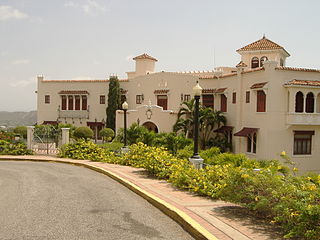
Bacardi Limited is the largest privately held, family-owned spirits company in the world. Originally known for its Bacardí brand of white rum, it now has a portfolio of more than 200 brands and labels. Founded in Cuba in 1862 by the Spanish businessmen Facundo Bacardí Massó, Bacardi Limited has been family-owned for seven generations, and employs more than 8,000 people with sales in approximately 170 countries. Bacardi Limited is the group of companies as a whole and includes Bacardi International Limited.

Mayagüez is the ninth-largest municipality in Puerto Rico. It was founded as Pueblo de Nuestra Señora de la Candelaria de Mayagüez, and is also known as La Sultana del Oeste, Ciudad de las Aguas Puras, or Ciudad del Mangó. On April 6, 1894, the Spanish Crown granted it the formal title of Excelente Ciudad de Mayagüez. Mayagüez is located in the center of the western coast on the island of Puerto Rico. It has a population of 73,077, and it is the principal city of the Mayagüez Metropolitan Statistical Area and the Mayagüez–Aguadilla, PR Combined Statistical Area.

Juan Eugenio Serrallés Colón (1836–1921) was the founder of Hacienda Mercedita in Ponce, Puerto Rico, and what was to become Destileria Serralles, producers of "Don Q", a brand of Puerto Rican rum.

Havana Club is a brand of rum created in Cuba in 1934. Originally produced in Cárdenas, Cuba, by family-owned José Arechabala S.A., the brand was nationalized after the Cuban Revolution of 1959. In 1993, French-owned Pernod Ricard and the government of Cuba created a state-run 50:50 joint venture called Corporación Cuba Ron. They began exporting this version of Havana Club globally, except for the United States due to the embargo put in place by the U.S. government.

Castillo Serrallés is a mansion located in the city of Ponce, Puerto Rico, overlooking the downtown area. It was built during the 1930s for Juan Eugenio Serrallés, son of businessman Juan Serrallés, founder of Destilería Serrallés. The structure sits on a 2.5-acre (1.0 ha) exceedingly manicured property. Nowadays, the structure functions as a museum, Museo Castillo Serrallés, with information about the sugar cane and rum industries and its impact in the economy of Puerto Rico. It is also increasingly used as a venue for social activities, including destination weddings. The property was listed in the National Register of Historic Places in 1980 and on the Puerto Rico Register of Historic Sites and Zones in 2001. In 1996, the structure was featured in the American TV series America's Castles.

Don Q is a Puerto Rican rum, distilled, manufactured, bottled, and distributed by Destilería Serrallés from its corporate facility in Ponce, Puerto Rico. Don Q, "Puerto Rico's best-known rum", is the top-selling rum in Puerto Rico, where over 70% of the rum consumed in the United States is produced. The rum derives its name from Don Quixote, the protagonist in Miguel de Cervantes' classic Spanish novel. The rum is sold internationally, competing against Bacardi for market share. Available in the continental United States since June 2009, Don Q continues to outsell Bacardi in Puerto Rico.

Destilería Serrallés is a rum producer located in Ponce, Puerto Rico, and best known for its Don Q rum brand. The company is Puerto Rico's oldest family-owned company and has revenues of over 100 million dollars. In 2011, it was responsible for pumping over $300 million annually into the Puerto Rican economy from the sale of its rums in the United States mainland alone.
Puertorriqueña de Aviación, previously known as Aerovías Nacionales de Puerto Rico was an airline company that operated during the 1930s. It was the first documented attempt by Puerto Ricans to have a flag carrier in the country.

Hacienda Mercedita was a 300-acre (120 ha) sugarcane plantation in Ponce, Puerto Rico, founded in 1861, by Juan Serrallés Colón. Today Hacienda Mercedita no longer grows sugarcane and its lands are instead used for growing mangoes, grasses, landscape plants and palms, coconut palms, bananas, and seeds.

The Museo de la Música Puertorriqueña is a museum in Ponce, Puerto Rico, that showcases the development of Puerto Rican music, with displays of Taíno, Spanish, and African musical instruments that were played in the romantic danza genre, the favorite music of 19th-century Puerto Rican high society, as well as the more African-inspired bomba and plena styles. Also on display are memorabilia of composers and performers. The Museum traces the rich musical history of Puerto Rico through memorabilia of prominent musicians and displays of the musical instruments associated with the three genres of music that originated in this Caribbean island.

Casa Serrallés is a historic building in the city of Ponce, Puerto Rico. It was built in 1911 by Alfredo Wiechers Pieretti for Don Juan Eugenio Serrallés Pérez, son of businessman Juan Serrallés Colón, founder of Destilería Serrallés, and himself the CEO of the company that founded Ron Don Q. The building is currently home to the Museo de la Música Puertorriqueña.

Casa Rosita Serrallés is a historic building in the city of Ponce, Puerto Rico, located between the former Escuela Libre de Música Juan Morel Campos and the Museo de la Historia de Ponce, and immediately behind Teatro La Perla, on Calle Salud street. It was built for one of the heirs of Juan Eugenio Serrallés Perez, son of businessman Juan Serrallés Colón, founder of Destilería Serrallés, and himself the CEO of the company that founded Ron Don Q. The building was purchased by the government of the Autonomous Municipality of Ponce in 2008 for its architectural, historic, and cultural value. As of February 2012, the building was being restored to convert it into an annex of the Museo de la Historia de Ponce to depict the 1985 Mameyes tragedy of barrio Portugues Urbano in Ponce. In 2014 it opened as "Museo de la Recordacion Barrio Mameyes" under Ponce mayor María Meléndez at Calle Salud 67. It is also known as "Sala Memorial del Barrio Mameyes" as it operates as a part of the Museo de la Historia de Ponce.
Industrias Licoreras de Guatemala is a Guatemalan alcohol distillery which produces different kinds of alcohol and which owns different brands. It was created at the beginning of the 20th century by Venancio, Andrés, Felipe, Jesús and Alejandro Botran, who emigrated from Spain to start a distillery business. It is a private company and it is the biggest of the three distilling companies operating in Guatemala.

Museo Castillo Serrallés, a.k.a. Museo de la Caña y el Ron, is an agricultural museum in the city of Ponce, Puerto Rico, that showcases the history of sugar cane, its derivative rum industry, and their impact in the economy of Puerto Rico. The most notorious feature of the museum is the building it occupies. The building is a large four-story structure built in the 1930s for the owner of Ponce's Destileria Serralles, one of Puerto Rico's largest rum distilleries. The distillery was once also home to Puerto Rico's largest sugar-factory called Central Mercedita, producers of the Snow White sugar brand. The building, known as Castillo Serrallés, was designed by Pedro Adolfo de Castro in 1930 in the Spanish Colonial Revival style.
Pitorro is a distilled spirit from Puerto Rico, referred to as "moonshine rum". Pitorro is usually much stronger than commercial rum. At times its alcohol content surpasses 100 proof. It is often homemade and a part of traditional Puerto Rican holiday celebrations, and used in Coquito.
Spanish settlement of Puerto Rico began in the early 1500s shortly after the formation of the Spanish state in 1493 and continues to the present day.
Palo Viejo is a Puerto Rican rum brand.










